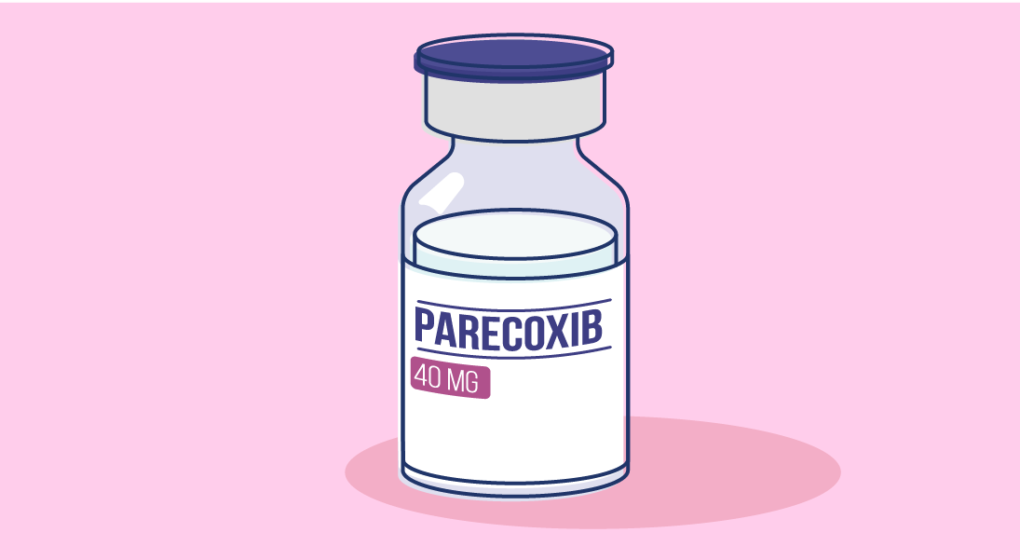
Parecoxib is a type of drug called a non-steroidal anti-inflammatory drug (NSAID). It works by stopping the production of compounds called prostaglandins in the body. Prostaglandins have a number of effects on your body, including causing inflammation, which is why it can help to reduce pain and inflammation. It is usually used to relieve pain after surgery.
What type of drug is it?
Parecoxib is a type of drug known as a non-steroidal anti-inflammatory drug (NSAID), which is a group of drugs that all work in a similar way. Other examples of NSAIDs include:
Parecoxib is a special type of NSAID, which we call a COX-2 selective NSAID. This is because it specifically blocks COX-2 (and not COX-1), which helps to reduce pain and inflammation with a lower risk of side effects. However, when you take higher doses of parecoxib, it also starts to affect COX-1, which is why only low doses are usually used.
What is Parecoxib used for?
Parecoxib is used to help relieve pain after surgery, known as post operative pain. Unlike other other NSAIDS, parecoxib is only available as an injection for use in hospitals or medical clinics.
It is not recommended for long term use because there is an increased risk of serious side effects, such as cardiovascular event.
How does it work?
Parecoxib works by inhibiting COX-2 (and COX-1 at higher doses), which is needed to produce some types of prostaglandins in your body.
You have many different types of prostaglandins in your body, with some in almost every tissue. They each have different effects on your body, such as to cause your blood vessels to relax and widen, the platelets in your blood to come together to form a clot, or the tissues in your body to become inflamed.
Unlike other general NSAIDs that block both COX-1 and COX-2, parecoxib usually only blocks the action of COX-2. Inflammation is mostly caused by the prostaglandins that produced with the help of COX-2. Therefore, parecoxib has a more targeted effect to reduce pain and inflammation, with fewer side effects from the COX-1 related prostaglandins, such as blood clotting and hypertension.
Side Effects
Even though Parecoxib has a more targeted effect than other NSAIDs because it only affects COX-2, you may still experience some side effects. These may include:
Nausea
Heartburn (dyspepsia)
Diarrhea
Headache
Dizziness
This is not a complete list of side effects, but just some of the most common. Please see the Parecoxib information leaflet for more detailed information.
Drug Interactions
Parecoxib can interact with many other medications when they are used in together, including:
Aldosterone antagonists
Alendronate
Brimonidine
Calcineurin inhibitors
Corticosteroids
Cyclosporin
Fluconazole
Lithium
Loop diuretics
Methotrexate
Phenindione
Potassium
Prostaglandin analogues
Rifampicin
Tacrolimus
Thiazide diuretics
Thiazolidinediones
Triamterene
Warfarin
These medications can often be used together, but your doctor should be aware that you are taking both medications so that they can adjust the dose as needed to ensure they are safe and effective.
Cautions
There are some people who may need to avoid using Parecoxib, or use it with caution, because they may be at risk of side effects due to the medication.
Peptic ulcers or GI bleeding:
Coagulation disorders:
Cardiovascular disease:
Asthma:
Inflammatory Bowel Disease (IBD):
Renal Impairment
Pregnancy and Breastfeeding
Parecoxib is not usually recommended for women who are pregnant or trying to conceive. This is because it can interfere with fertility and the development of the fetus.
For women planning to become pregnant, it can prevent or delay ovulation, so that the woman is less likely to conceive. Additionally, using parecoxib during pregnancy, particularly at the time of conception, is linked to a higher risk of miscarriage. It may also cause other problems later on in the pregnancy and should be avoided.
For women who are breastfeeding, parecoxib is considered safe to use.
Pin it!


